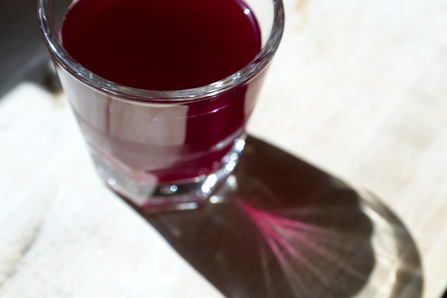
Beet Kvass
A delicious, modern take on a traditional Eastern European brew,this beet kvass recipe makes a tonic beverage that's both nourishing and supremely refreshing. Eastern European tradition has long held that beet kvass is a superb blood & liver cleanser, a probiotic, & supporter of digestive health & regularity, as well as being alkalizing & anti-inflammatory. It's hard to do justice to this beverage!
Our farmhouse recipe incorporates several of the herbs that we grow on our farm to bolster the kvass's nourishing and tonifying properties.
Fill a half-gallon jar or crock with...
Stir ingredients together in the jar, then seal with a lid and set aside out of direct sunlight in a room-temperature setting. Taste about every day to note progress. After 2-3 days, you can move it to the refrigerator, where it will keep fermenting, although at a much slower pace. It should be well fermented (this is not alcoholic fermentation) within 3-7 days.
When it tastes to your liking, and has a pleasant fizziness, strain and enjoy! If you don't strain out the ingredients however, you can get another batch out of them.
Let the kvass continue:
Once there's about 1/4-1/2 cup of fluid remaining, fill your jar again with water and set aside for another few days. If you like the stevia sweetness, you may want to add another pinch or two. After this second steep, strain, and retain at least 1/4 cup of kvass to start the next batch, composting the remaining beets or serving them on a salad. If you do not wish to make another batch right away, then you may refrigerate the kvass starter temporarily.
A delicious, modern take on a traditional Eastern European brew,this beet kvass recipe makes a tonic beverage that's both nourishing and supremely refreshing. Eastern European tradition has long held that beet kvass is a superb blood & liver cleanser, a probiotic, & supporter of digestive health & regularity, as well as being alkalizing & anti-inflammatory. It's hard to do justice to this beverage!
Our farmhouse recipe incorporates several of the herbs that we grow on our farm to bolster the kvass's nourishing and tonifying properties.
Fill a half-gallon jar or crock with...
- 2 large red beets, chopped into 1/2 inch chunks. Do not skin beets, but do remove tops & tails.
- 1-2 teaspoons dried stevia leaf (for some sweetness)
- 2 tablespoons fresh ginger, minced (or 1 tablespoon powdered)
- 2 tablespoons fresh or dried burdock root (optional)
- 2 tablespoons fresh or dried diced dandelion root (optional)
- 2 teaspoons salt (not iodized)
- 1/4 cup starter (from lacto-fermented foods such as sauerkraut) or whey
- Enough fresh water to fill up to 1 inch below top of jar (if using chlorinated water, leave out for 20 minutes to let the chlorine dissipate)
Stir ingredients together in the jar, then seal with a lid and set aside out of direct sunlight in a room-temperature setting. Taste about every day to note progress. After 2-3 days, you can move it to the refrigerator, where it will keep fermenting, although at a much slower pace. It should be well fermented (this is not alcoholic fermentation) within 3-7 days.
When it tastes to your liking, and has a pleasant fizziness, strain and enjoy! If you don't strain out the ingredients however, you can get another batch out of them.
Let the kvass continue:
Once there's about 1/4-1/2 cup of fluid remaining, fill your jar again with water and set aside for another few days. If you like the stevia sweetness, you may want to add another pinch or two. After this second steep, strain, and retain at least 1/4 cup of kvass to start the next batch, composting the remaining beets or serving them on a salad. If you do not wish to make another batch right away, then you may refrigerate the kvass starter temporarily.